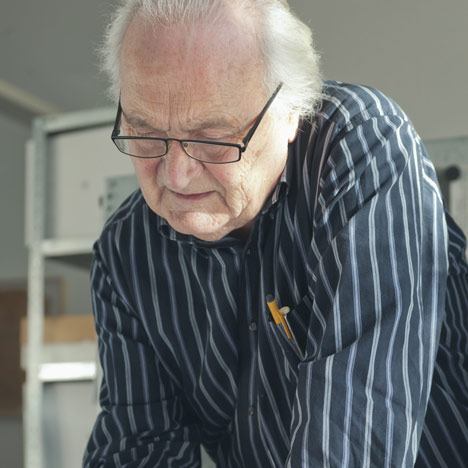Here's a selection of projects by Dutch architect Herman Hertzberger, who was named as this year's Royal Gold Medal recipient this morning.
Top: portrait by Hans van den Bogaard
Above: Montessori School, Delft (1960-66), photograph is by Johan van der Keuken
Hertzberger will receive the prize in February 2012 - more details in our earlier Dezeen Wire story.
Above: Montessori School, Delft (1960-66), photograph is by Herman van Doorn
Here's Hertzberger's biography from the RIBA:
Born in 1932 Herman Hertzberger opened his own firm of architects in 1960, the present-day Architectuurstudio HH in Amsterdam. One of his major influences on 20th century architecture was to challenge the early modernist belief that ‘form follows function’ - that the shape of the building was defined by its purpose.
Above: Lin Mij Textile Workshop, Amsterdam (1962-64), demolished, photograph is by Jan Versnel
Hertzberger believes that the core function of a building does not provide the total solution to space usage: it is a framework that should enable its users to interpret and define how they inhabit it.
Above: Lin Mij Textile Workshop, Amsterdam (1962-64), demolished, photograph is by Jan Versnel
His buildings offer flexible ‘in between’ spaces that encourage our deeper human needs of dwelling and social activity.
Above: Centraal Beheer Apeldoorn (1968-72), photograph is by Aviodrome Luchtfotografie
His celebrated Montessori School in Delft (1960-66) rethought the way that classrooms were laid out, with L-shaped rooms creating different zones.
Above: Centraal Beheer Apeldoorn (1968-72), photograph is by Willem Diepraam
Images of children playing and learning on broad wooden steps as a creative space inspired many architects of schools across northern Europe.
Above: Centraal Beheer Apeldoorn (1968-72), photograph is by Willem Diepraam
His exemplary workplace Central Baheer in Apeldoorn (1968-72) was designed with the needs of the individual at its core and the Ministry of Social Affairs and Employment in The Hague (1979-90) was one of the first buildings to develop the idea of the internal street or elongated atrium to encourage social interaction and get light into all the rooms.
Above: Diagoon Housing, Delft (1969-70)
Above: Apolloscholen, Amsterdam (1980-83), photograph is by Frits Dijkhof
Above: Apolloscholen, Amsterdam (1980-83)
Above: YKK Dormitory, Kurobe, Japan (1991-98)
Above: YKK Dormitory, Kurobe, Japan (1991-98)
Above: Chasse Concert Hall, Breda (1992-95), photograph is by Herman van Doorn
Above: Chasse Concert Hall, Breda (1992-95), photograph is by Herman van Doorn
Above: Waternet Head Office, Amsterdam (2000-05), photograph is by Duccio Malagamba
Above: Waternet Head Office, Amsterdam (2000-05), photograph is by Duccio Malagamba
Above: Media Park & Housing Cologne, Germany (2004-04), photgraph is by Duccio Malagamba
Above: NHL University Leeuwarden (2004-10), photograph is by John Lewis Marshall
Above: NHL University Leeuwarden (2004-10), photograph is by John Lewis Marshall
Above: NHL University Leeuwarden (2004-10)
Above: Coda Shelter for Culture (museum) Apeldoorn (2004-11), photograph is by Herman van Doorn
Above: Coda Shelter for Culture (museum) Apeldoorn (2004-11), photograph is by Herman van Doorn
Above: Faculty of Science University of Utrecht (2006-11)
Above: Faculty of Science University of Utrecht (2006-11), photograph is by Rob Hoekstra

